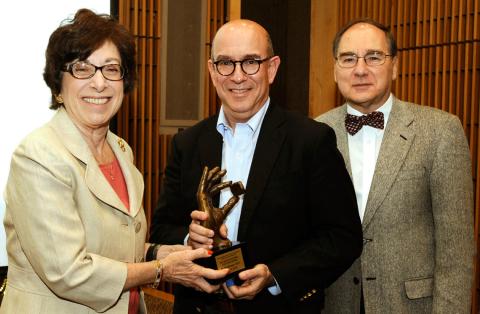18th Year
Rodbell Lecture Spotlights Role of Hormones in Cancer

Photo: Steve McCaw
The NIEHS Dr. Martin Rodbell Lecture Series Seminar honors the former NIEHS scientific director, who gave the first talk in 1998 just weeks before his death. The 1994 Nobel Prize in physiology or medicine was awarded jointly to Rodbell and Dr. Alfred Gilman “for their discovery of G-proteins and the role of these proteins in signal transduction in cells.”
The year-long celebration of the NIEHS 50th anniversary included recognition of the 18th year of the series and featured Dr. Myles Brown of Dana-Farber Cancer Institute, who has changed the way researchers think about the role of hormones in breast and prostate cancer. In his recent talk, “Hacking the Hormone Code,” Brown said he read that Rodbell’s experience as a signalman in the Navy inspired his discovery of the first biochemical evidence for how G-proteins transport hormonal signals from the surface of a cell to secondary messengers inside the cell.
“Rodbell sent radio signals, and he was thinking about how cells communicate with each other,” Brown said. “Much of what he taught us continues to be true today, and we’ve been spending the last 30 to 40 years filling in the details.”
Brown is interested in why hormone-dependent cancers are so responsive to steroid hormones and why endocrine therapies that target these hormones or their receptors work only in some patients while others develop resistance. He said recent scientific research points to mutations that cluster in the estrogen receptor ligand-binding domain, which binds estradiol and is responsible for sending the strongest transcriptional signal.
A member of Brown’s lab found that one mutation, known as Y537C, is the most common resistance mutation in patients with such relapses. This may explain why resistance develops and provides a basis for development of a pharmaceutical compound that targets the mutation.
“We found it in about 17 percent of our cohort, but using more sensitive techniques, others are finding it in 25 to 30 percent of patients,” Brown said. “I think it’s strong evidence that in at least a third of those tumors, the cancer cells are ER+ and depend on the presence of the mutation.”
Other scientists have identified prostate cancer mutations in a protein called SPOP. The prevailing theory is that SPOP stabilizes a group of proteins involved in DNA repair and cell signaling. The mutations remove the scaffolding from these important molecules, setting prostate cells on a path to cancer.
One target of SPOP, a gene called TRIM24, promotes the growth of prostate cancer cells. By removing TRIM24 in castration-resistant prostate cancer cell lines, Brown was able to slow growth of the cancer. Although medicines that more effectively block the effect of androgen have been approved for castration-resistant prostate cancer, patients almost invariably relapse. Brown believes compounds that target TRIM24 could be developed.
“Myles Brown was a perfect choice as the 2016 Rodbell lecturer, since he exemplifies the same outstanding research and insights as Marty Rodbell,” said Dr. Ken Korach, chief of NIEHS’s Reproductive and Developmental Biology lab, who hosted the talk.
